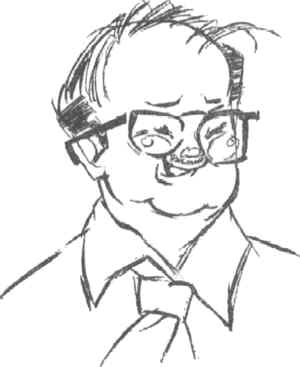| … born Feb. 26, 1908, in a small Texas town called Taylor. He contributed cartoons to his high school yearbook, and sold a few more to local publicatios. He studied at The Chicago Art Institute, where he got to rub elbows with a few Chicago Tribune artists, who served as instructors. After that, he took off for California to look for cartooning work.
He didn't have much success, until he heard Universal Studios' animation department was hiring. He applied, and producer Walter Lantz put him to work in the ink and paint department. He worked his way up to in-betweener, and that's how he learned the basic skills necessary to make his drawings appear to move. A few years later, he was making them move the way nobody else ever had. Today, his name connotes a style of zany, over-the-top animation that had never been seen in the world until he invented it.
It was shortly after he began in-betweening that Disney raided the staff, and with jobs suddenly vacant Avery became a full-fledged animator. With that on his resume, he applied at Leon Schlesinger's studio, where the Warner Bros. cartoons were made, and was hired as a director. His first cartoon was a Porky Pig opus titled Gold Diggers of '49, which was released January 6, 1936. In '37, as a supporting character in another Porky cartoon, he introduced his first major creation — Daffy Duck.
Avery was also instrumental in the development of Bugs Bunny and Elmer Fudd (who was in part a modification of Avery's earlier character, Egghead). And he developed talent as well as characters — Chuck Jones (Road Runner, How the Grinch Stole Christmas), Bob Clampett (Tweety Bird, Beany & Cecil) and Bobe Cannon (Gerald McBoing-Boing, Mr. Magoo) were among his early assistants.
In 1941, Avery quarrelled with Schlesinger over a series idea, comedy shorts featuring live-action animals with animated mouths dubbed onto their faces (a technique which may or may not have inspired the technique used to "animate" Clutch Cargo). The argument became so heated, Schlesinger suspended Avery from his job for eight weeks — during which time Avery sold the series to Paramound Pictures, where, under the title Speaking of Animals, it ran seven years and won an Academy Award. When the eight weeks were up, Avery didn't go back.
In 1942, he became a cartoon director for MGM, where he promptly created Droopy and Screwy Squirrel. He was also responsible for a series of hilarious send-ups of fairy tales, featuring an unnamed wolf character teamed with a sexy redhead, starting with Red Hot Riding Hood (1943), and for some of the funniest non-series cartoons of the 1940s and '50s.
Avery returned to Lantz in 1954, and continued his habit of strewing classic characters wherever he went. Tho he directed only four cartoons there, they included I'm Cold (1954), the one that established Chilly Willy as a star.
Following a contract dispute with Lantz, Avery went into commercial animation. Classic characters he created in that venue include the Raid bugs and The Frito Bandito. He also, occasionally, got to work on some of his old Warner Bros. creations, once they started doing product endorsements. He continued to work on commercials for more than two decades.
In 1979, 71 years of age, he went back to the entertainment business, taking a job with his former co-workers at MGM, Bill Hanna and Joe Barbera. Hanna-Barbera was the only place he ever worked where he didn't leave stars in his wake. His best known characters there were Kwicky Koala (a highly derivative character) and Dino & the Cave Mouse (a Flintstones spin-off, strongly reminiscent of Tom & Jerry).
Perhaps, tho, he'd have left them with a classic or two if he'd had more time. He died on August 26, 1980.
— DDM
BACK to Don Markstein's Toonopedia™ Home Page
Today in Toons: Every day's an anniversary!
| |
Purchase Warner Bros. Cartoon Merchandise Online
|
